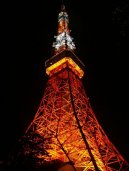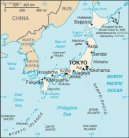Japan
Japan: Travel tips, articles, photos, gallery, cities database, population, pics, flags, statistics, free maps online
Back to Countries, Click to read the whole article: Japan
| Introduction - Japan: | | Location - Japan: | | People - Japan: | | Government - Japan: | | Economy - Japan: | Economy overview | Government-industry cooperation, a strong work ethic, mastery of high technology, and a comparatively small defense allocation (1% of GDP) helped Japan advance with extraordinary rapidity to the rank of second most technologically powerful economy in the world after the US and the third-largest economy in the world after the US and China, measured on a purchasing power parity (PPP) basis. One notable characteristic of the economy has been how manufacturers, suppliers, and distributors have worked together in closely-knit groups called keiretsu. A second basic feature has been the guarantee of lifetime employment for a substantial portion of the urban labor force. Both features have now eroded. Japans industrial sector is heavily dependent on imported raw materials and fuels. The tiny agricultural sector is highly subsidized and protected, with crop yields among the highest in the world. Usually self sufficient in rice, Japan must import about 60% of its food on a caloric basis. Japan maintains one of the worlds largest fishing fleets and accounts for nearly 15% of the global catch. For three decades, overall real economic growth had been spectacular - a 10% average in the 1960s, a 5% average in the 1970s, and a 4% average in the 1980s. Growth slowed markedly in the 1990s, averaging just 1.7%, largely because of the after effects of overinvestment and an asset price bubble during the late 1980s that required a protracted period of time for firms to reduce excess debt, capital, and labor. From 2000 to 2001, government efforts to revive economic growth proved short-lived and were hampered by the slowing of the US, European, and Asian economies. In 2002-06, growth improved and the lingering fears of deflation in prices and economic activity lessened. Japans huge government debt, which totals 176% of GDP, and the aging of the population are two major long-run problems. Some fear that a rise in taxes could endanger the current economic recovery. Debate also continues on the role of and effects of reform in restructuring the economy, particularly with respect to the 2007-17 privatization of Japan Post, which has functioned not only as the national postal delivery system but also, through its banking and insurance facilities, as Japans largest financial institution. | | Gdp purchasing power parity | $4.218 trillion (2006 est.) | | Gdp official exchange rate | $4.883 trillion (2006 est.) | | Gdp real growth rate | 2.2% (2006 est.) | | Gdp per capita ppp | $33,100 (2006 est.) | | Gdp composition by sector | agriculture: 1.6%
industry: 25.3%
services: 73.1% (2006 est.) | | Labor force | 66.44 million (2006 est.) | | Labor force by occupation | agriculture: 4.6%
industry: 27.8%
services: 67.7% (2004) | | Unemployment rate | 4.1% (2006 est.) | | Population below poverty line | NA% | | Household income or consumption by percentage share | lowest 10%: 4.8%
highest 10%: 21.7% (1993) | | Distribution of family income gini index | 38.1 (2002) | | Inflation rate consumer prices | 0.3% (2006 est.) | | Investment gross fixed | 23.7% of GDP (2006 est.) | | Budget | revenues: $1.411 trillion
expenditures: $1.639 trillion; including capital expenditures (public works only) of about $71 billion (2006 est.) | | Public debt | 176.2% of GDP (2006 est.) | | Agriculture products | rice, sugar beets, vegetables, fruit; pork, poultry, dairy products, eggs; fish | | Industries | among worlds largest and technologically advanced producers of motor vehicles, electronic equipment, machine tools, steel and nonferrous metals, ships, chemicals, textiles, processed foods | | Industrial production growth rate | 3.3% (2006 est.) | | Electricity production | 996 billion kWh (2005) | | Electricity consumption | 946.3 billion kWh (2005) | | Electricity exports | 0 kWh (2005) | | Electricity imports | 0 kWh (2005) | | Oil production | 125,000 bbl/day (2006) | | Oil consumption | 5.578 million bbl/day (2005) | | Oil exports | 94,830 bbl/day (2004) | | Oil imports | 5.425 million bbl/day (2004) | | Oil proved reserves | 58.5 million bbl (1 January 2005) | | Natural gas production | 2.957 billion cu m (2004 est.) | | Natural gas consumption | 83.55 billion cu m (2004 est.) | | Natural gas exports | 0 cu m (2004 est.) | | Natural gas imports | 81.23 billion cu m (2004 est.) | | Natural gas proved reserves | 39.64 billion cu m (1 January 2005 est.) | | Current account balance | $174.4 billion (2006 est.) | | Exports | $590.3 billion f.o.b. (2006 est.) | | Exports commodities | transport equipment, motor vehicles, semiconductors, electrical machinery, chemicals | | Exports partners | US 22.8%, China 14.3%, South Korea 7.8%, Taiwan 6.8%, Hong Kong 5.6% (2006) | | Imports | $524.1 billion f.o.b. (2006 est.) | | Imports commodities | machinery and equipment, fuels, foodstuffs, chemicals, textiles, raw materials | | Imports partners | China 20.5%, US 12%, Saudi Arabia 6.4%, UAE 5.5%, Australia 4.8%, South Korea 4.7%, Indonesia 4.2% (2006) | | Reserves of foreign exchange and gold | $864.7 billion (August 2006 est.) | | Economic aid donor | ODA, $8.9 billion (2004) | | Debt external | $1.547 trillion (30 June 2006) | | Currency code | yen (JPY) | | Exchange rates | yen per US dollar - 116.18 (2006), 110.22 (2005), 108.19 (2004), 115.93 (2003), 125.39 (2002) | |
| Communications - Japan: | | Transportation - Japan: | | Military - Japan: |
This page was last updated on 16 September, 2007
Source: CIA >>> |




